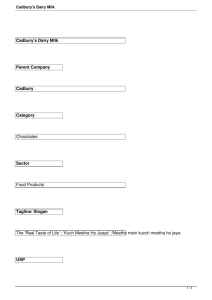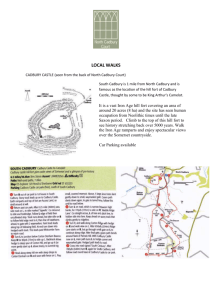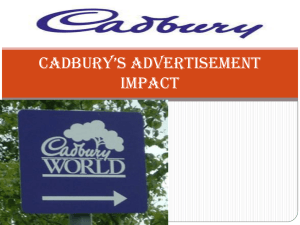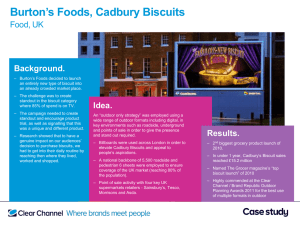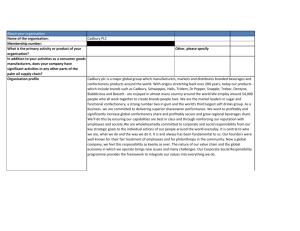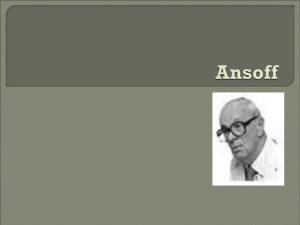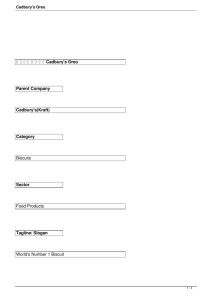brand development by identifying brand values
advertisement
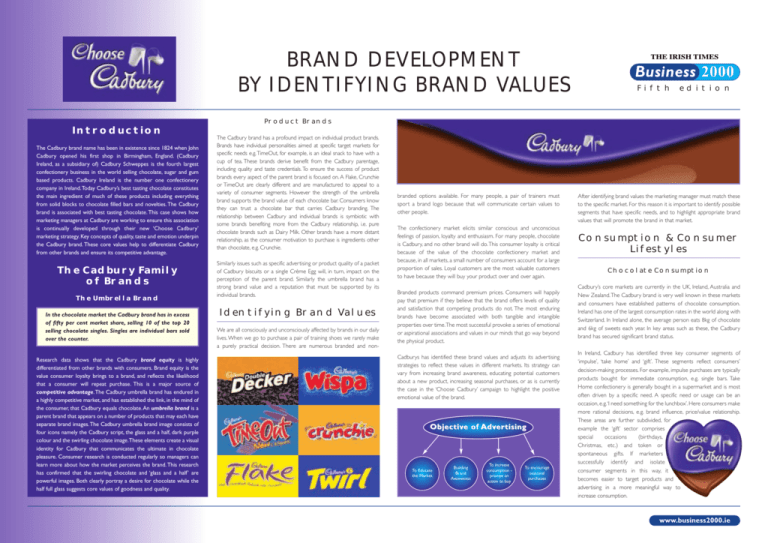
BRAND DEVELOPMENT BY IDENTIFYING BRAND VALUES Business 2000 Fifth edition Product Brands Introduction The Cadbury brand name has been in existence since 1824 when John Cadbury opened his first shop in Birmingham, England. (Cadbury Ireland, as a subsidiary of) Cadbury Schweppes is the fourth largest confectionery business in the world selling chocolate, sugar and gum based products. Cadbury Ireland is the number one confectionery company in Ireland.Today Cadbury’s best tasting chocolate constitutes the main ingredient of much of these products including everything from solid blocks to chocolate filled bars and novelties. The Cadbury brand is associated with best tasting chocolate. This case shows how marketing managers at Cadbury are working to ensure this association is continually developed through their new ‘Choose Cadbury’ marketing strategy. Key concepts of quality, taste and emotion underpin the Cadbury brand. These core values help to differentiate Cadbury from other brands and ensure its competitive advantage. The Cadbury Family of Brands The Umbrella Brand In the chocolate market the Cadbury brand has in excess of fifty per cent market share, selling 10 of the top 20 selling chocolate singles. Singles are individual bars sold over the counter. Research data shows that the Cadbury brand equity is highly differentiated from other brands with consumers. Brand equity is the value consumer loyalty brings to a brand, and reflects the likelihood that a consumer will repeat purchase. This is a major source of competitive advantage.The Cadbury umbrella brand has endured in a highly competitive market, and has established the link, in the mind of the consumer, that Cadbury equals chocolate.An umbrella brand is a parent brand that appears on a number of products that may each have separate brand images.The Cadbury umbrella brand image consists of four icons namely the Cadbury script, the glass and a half, dark purple colour and the swirling chocolate image.These elements create a visual identity for Cadbury that communicates the ultimate in chocolate pleasure. Consumer research is conducted regularly so managers can learn more about how the market perceives the brand. This research has confirmed that the swirling chocolate and ‘glass and a half’ are powerful images. Both clearly portray a desire for chocolate while the half full glass suggests core values of goodness and quality. The Cadbury brand has a profound impact on individual product brands. Brands have individual personalities aimed at specific target markets for specific needs e.g.TimeOut, for example, is an ideal snack to have with a cup of tea. These brands derive benefit from the Cadbury parentage, including quality and taste credentials. To ensure the success of product brands every aspect of the parent brand is focused on. A Flake, Crunchie or TimeOut are clearly different and are manufactured to appeal to a variety of consumer segments. However the strength of the umbrella brand supports the brand value of each chocolate bar. Consumers know they can trust a chocolate bar that carries Cadbury branding. The relationship between Cadbury and individual brands is symbiotic with some brands benefiting more from the Cadbury relationship, i.e. pure chocolate brands such as Dairy Milk. Other brands have a more distant relationship, as the consumer motivation to purchase is ingredients other than chocolate, e.g. Crunchie. Similarly issues such as specific advertising or product quality of a packet of Cadbury biscuits or a single Crème Egg will, in turn, impact on the perception of the parent brand. Similarly the umbrella brand has a strong brand value and a reputation that must be supported by its individual brands. Identifying Brand Values We are all consciously and unconsciously affected by brands in our daily lives. When we go to purchase a pair of training shoes we rarely make a purely practical decision. There are numerous branded and non- branded options available. For many people, a pair of trainers must sport a brand logo because that will communicate certain values to other people. The confectionery market elicits similar conscious and unconscious feelings of passion, loyalty and enthusiasm. For many people, chocolate is Cadbury, and no other brand will do. This consumer loyalty is critical because of the value of the chocolate confectionery market and because, in all markets, a small number of consumers account for a large proportion of sales. Loyal customers are the most valuable customers to have because they will buy your product over and over again. Branded products command premium prices. Consumers will happily pay that premium if they believe that the brand offers levels of quality and satisfaction that competing products do not. The most enduring brands have become associated with both tangible and intangible properties over time.The most successful provoke a series of emotional or aspirational associations and values in our minds that go way beyond the physical product. Cadburys has identified these brand values and adjusts its advertising strategies to reflect these values in different markets. Its strategy can vary from increasing brand awareness, educating potential customers about a new product, increasing seasonal purchases, or as is currently the case in the ‘Choose Cadbury’ campaign to highlight the positive emotional value of the brand. Objectiv e of Adver tising To Educate the Market Building Brand Awareness To increase consumption prompt an action to buy To encourage seasonal purchases After identifying brand values the marketing manager must match these to the specific market. For this reason it is important to identify possible segments that have specific needs, and to highlight appropriate brand values that will promote the brand in that market. Consumption & Consumer Lifestyles Chocolate Consumption Cadbury’s core markets are currently in the UK, Ireland, Australia and New Zealand.The Cadbury brand is very well known in these markets and consumers have established patterns of chocolate consumption. Ireland has one of the largest consumption rates in the world along with Switzerland. In Ireland alone, the average person eats 8kg of chocolate and 6kg of sweets each year. In key areas such as these, the Cadbury brand has secured significant brand status. In Ireland, Cadbury has identified three key consumer segments of ‘impulse’, ‘take home’ and ‘gift’. These segments reflect consumers’ decision-making processes. For example, impulse purchases are typically products bought for immediate consumption, e.g. single bars. Take Home confectionery is generally bought in a supermarket and is most often driven by a specific need. A specific need or usage can be an occasion, e.g.‘I need something for the lunchbox’. Here consumers make more rational decisions, e.g. brand influence, price/value relationship. These areas are further subdivided, for example the ‘gift’ sector comprises special occasions (birthdays, Christmas, etc.) and token or spontaneous gifts. If marketers successfully identify and isolate consumer segments in this way, it becomes easier to target products and advertising in a more meaningful way to increase consumption. www.business2000.ie New Products Reflecting Consumer Lifestyles The ‘Choose Cadbury’ Marketing Strategy New product development has played a key role in developing markets as brands strive to offer something to a consumer that is truly different. We take a crumbly flake texture or honeycomb for granted but, when introduced, they were remarkably innovative. Changing lifestyle patterns; eating on the go, and impulse snacking has and continues to play a pivotal role in the confectionary market. Continued snacking or ‘grazing’ has replaced traditional mealtimes for many people. The ‘glass and a half ’, corporate purple and flowing script has become synonymous with Cadbury: these design elements have been used to great effect in developing the connotation of goodness that this imagery suggests. In the 1980s another vital attribute - taste - was highlighted. Regardless of national preferences about how chocolate should taste (e.g. dark chocolate is traditionally more popular in Europe whereas Australians prefer creamier milk chocolate) the implication was clear Cadbury offers taste and texture that appeals to all. In the 1990s further emphasis was placed on ‘taste’. The strapline ‘Chocolate is Cadbury’, which was built upon previous brand values and allowed Cadbury to stake its claim and taking ownership of the word ‘chocolate’ and the chocolate eating experience. The Cadbury product range addresses the needs of each and every consumer, from childhood to maturity, from impulse purchase to family treats. For example an analysis of the ‘gift’ sector highlights the importance of developing innovative products to address specific markets. Cadbury designs products to coincide with Christmas, Easter, Valentine’s, Mother’s and Father’s Day and other calendar landmarks. Cadbury use marketing strategies such as the ‘Choose Cadbury’ strategy to encourage a link between chocolate and these events ensuring there is a Cadbury chocolate product suitable and available for every occasion. Anniversaries Mother’s Day Easter Mature Adults Mums Earlier this year, Cadbury introduced a new global marketing strategy called ‘Choose Cadbury’. This strategy came about as a result of extensive research into consumer behaviour and perception. It is a campaign that perfectly illustrates how a brand can evolve and how different messages can be communicated without losing the core strength and brand values that are already established. The central message of the ‘Choose Cadbury’ strategy hinges on the established glass and a half symbol. Is the glass half full or half empty? Cadbury suggests that the glass is always half full appealing to our emotions. Therefore, in choosing Cadbury we are taking a decision to embrace the positive.This optimistic metaphor is, according to consumer testing in the UK and Australia, well understood amongst consumers. In this ‘Choose Cadbury’ campaign, the product ingredient of milk has been elevated from a practical, rational platform to an emotional one Cadbury can deliver on optimism, happiness and a feel-good factor. If a brand can do all this, the decision to purchase this brand over all other chocolate brands seems to be logical and inevitable. The ‘Choose Cadbury’ strapline is a call to action designed to motivate us.We are not expected to simply absorb the advertising message, we are being called upon to make a conscious purchase decision. We are reassured that the Cadbury product will remain unchanged, (Cadbury is Chocolate and it still tastes good), but we are given more reasons to remain brand loyal (Cadbury is Chocolate – feels good i.e. positive, uplifting, mood enhancing, providing enjoyment and happiness). At no stage in the evolution of the Cadbury brand has there been as much reliance on taking ownership of the emotional side of eating chocolate as there is now. Owning the emotional territory for chocolate helps Cadbury to elevate its product in the mind of the consumer. With the ‘Choose Cadbury’ campaign consumers are being offered both logical and emotional reasons to buy a Cadbury product as a first option on every occasion. Conclusion Christmas Adults Father’s Day Teens Valentine’s Kids Birthdays Developing an Advertising Message Why Advertising is Used to Promote a Brand The confectionery market is full of brands that need to fight for our attention. The role of advertising is to keep a brand in the mind of the consumer.We are constantly presented with countless brand images and messages on a daily basis. During the lifetime of a brand, companies will develop marketing strategies that communicate brand identity and core values to gain our attention. In order to keep its product competitive and contemporary, these messages need to change over time. Cadbury provides one of the most successful examples of how an advertising message can be modified from one campaign to the next to attribute new values to a brand giving consumers more reasons to buy Cadburys. Healthy brand equity or brand strength is critical in an impulse-driven, competitive market. Advertising plays a key role in maintaining this strength. Cadbury employs all types of advertising from the internet to posters, from TV, radio and cinema to print media. This same creative message is then communicated through point of sale, merchandising, package design and public relations. Business 2000 Fifth edition The classic icons have played a major role in establishing the look and feel of how Cadbury’s advertisements should look through successive campaigns. These key ‘look and feel’ icons were heavily researched to ensure that the messages they impart are always relevant to the Cadbury consumer. In depth customer research is conducted to ‘test’ these messages. Research results confirmed that colour recognition of dark purple is strongly associated with Cadbury. Its logo is readily recognised and scores a ninety six per cent recognition level alongside other global brands such as Coca Cola and McDonalds. The glass and a half symbol, which plays a key role in the current ‘Choose Cadbury’ strategy, continues to communicate the quality and superior taste of Cadbury’s chocolate. The success of the Cadbury brand can be seen in how its image is continually maintained over time. Identifying brand values, and matching these to consumer lifestyles in specific market segments can help develop a clear advertising message. In previous advertising messages quality and taste were emphasized. Cadbury is now building on this through its ‘Choose Cadbury’ strategy to underline the feeling a premium brand can bring to its customers.The Cadbury brand has proven itself to be a leader in a highly volatile and competitive market because it has successfully established, nurtured and developed its umbrella brand and growing portfolio of products. Ta s k s a n d A c t i v i t i e s 1. Explain the benefits and value an umbrella brand can bring to a family of branded products. 2. Define the following terms a) Brand b) Consumer Motivation c) Brand Values 3. In your opinion why is it important to understand consumer lifestyles where trying to market a new product? 4. What is a ‘decision making process’? How do you think marketers use this to ensure a product is successful? 5. What is the objective of advertising a brand? Explain this by referring to the ‘Choose Cadbury’ marketing strategy. 6. How is Cadbury positioning the umbrella brand through its ‘Choose Cadbury’ marketing strategy? www.business2000.ie
